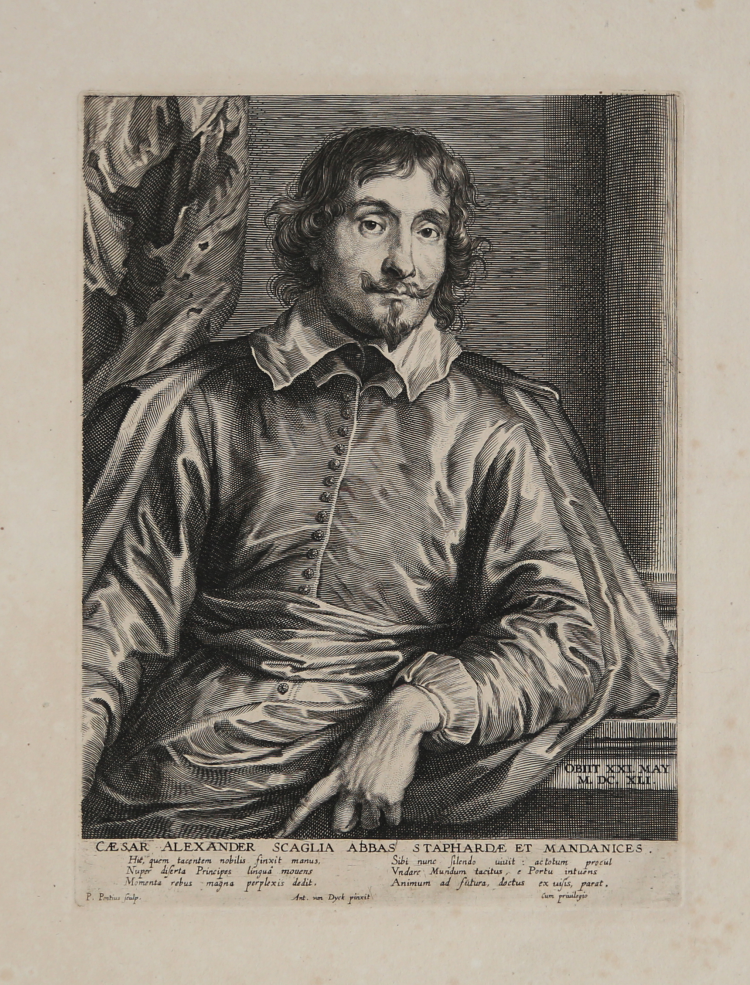



| Reference: | S7544 |
| Author | Paulus PONTIUS |
| Year: | 1645 ca. |
| Measures: | 182 x 270 mm |


| Reference: | S7544 |
| Author | Paulus PONTIUS |
| Year: | 1645 ca. |
| Measures: | 182 x 270 mm |
Etching and engraving, circa 1645, signed on plate at lower edge.
A fine impression, printed on contemporary laid paper, with margins, very good condition.
From Icones principum, virorum, doctorum, pictorum, chalcographorum by Anton van Dyck, printed for the first time in Antwerp, 1645.
A famous and important work, a real monument of the Flemish engraving art of the XVIII century, containing the biographies and portraits of the famous artists Van Dyck had met and with whom he had worked.
Following the success of his portrait paintings and in the tradition of Italian and Flemish portrait series, Van Dyck decided to organise a print publication containing portraits of the most prominent men during his lifetime, divided into three categories: princes, politicians and soldiers (16), statesmen and scholars (12), artists and art connoisseurs (52).
The initial idea could have been that Van Dyck would etch the faces (a process possibly learnt from Vorsterman) while others would finish the plates in engraving. Designs were needed for the plates and several drawings and oil sketches (grisailles, sometimes in different versions) have survived. Van Dyck only etched 17 plates himself, while he commissioned others to complete the set, overseen by Lucas Vorsterman I (especially after Van Dyck settled in England in the Spring of 1632). Although this project was started by Van Dyck around 1630, he never saw it completed.
The Antwerp publisher Maarten van den Enden may have been involved from the start as eighty early impressions bear Van den Enden's address. They are engraved by Paulus Pontius (30 plates), Lucas Vorsterman I (22), Pieter de Jode II (12), Schelte a Bolswert (7), Robert van Voerst (4), Willem Hondius (2), Willem Jacobsz Delff (1), Cornelis Galle (1), and Nicolaes Lauwers (1). It is known that Van den Enden was in debt to Gillis Hendricx around 1644, the Antwerp publisher who must have obtained Van den Enden's plates which he published in 1645 in the first edition of these plates (containing between 100 and 104 portrait plates).
Hendricx continued to publish these plates until his death in 1677 when they were auctioned off by the St Luke guild (keeping the Iconography plates together). It is not clear who bought these plates but they re-appeared around 1720 when they were published by Hendrick and Cornelis Verdussen in Antwerp.
Paulus PONTIUS (Anversa 1603 – 1658)
|
By the time Paulus Pontius (lat. for Paul du Pont) was twenty-four, he had become a master in the Antwerp guild and was the primary artist responsible for making engravings after the work of Peter Paul Rubens. In fact, Pontius lived in Rubens's home until a year after the painter's death. Having trained as a painter prior to studying engraving, Pontius developed a style "that accurately conveys the nature of the original painting." After Rubens's death, Pontius went on to make engravings after other artists, including Anthony van Dyck, Titian, and Velazquez. He also became very well known as a portrait engraver.
|
Paulus PONTIUS (Anversa 1603 – 1658)
|
By the time Paulus Pontius (lat. for Paul du Pont) was twenty-four, he had become a master in the Antwerp guild and was the primary artist responsible for making engravings after the work of Peter Paul Rubens. In fact, Pontius lived in Rubens's home until a year after the painter's death. Having trained as a painter prior to studying engraving, Pontius developed a style "that accurately conveys the nature of the original painting." After Rubens's death, Pontius went on to make engravings after other artists, including Anthony van Dyck, Titian, and Velazquez. He also became very well known as a portrait engraver.
|